 Gloriously diverse and artistically impressive picture books filled the shelves of libraries and bookstores during 2013. Anyone wanting to add to their collection of picture books will find it quite easy to find something from the list. The problem might be deciding exactly how many books to purchase. As part of the end of the year round-up of titles that caught our eyes and delighted our imaginations, members of the Children’s Literature and Reading Special Interest Group celebrate the approaching holidays with our favorite picture books of the year. Since picture books may be used at any grade level, we have not separated our offerings by grade level.
Gloriously diverse and artistically impressive picture books filled the shelves of libraries and bookstores during 2013. Anyone wanting to add to their collection of picture books will find it quite easy to find something from the list. The problem might be deciding exactly how many books to purchase. As part of the end of the year round-up of titles that caught our eyes and delighted our imaginations, members of the Children’s Literature and Reading Special Interest Group celebrate the approaching holidays with our favorite picture books of the year. Since picture books may be used at any grade level, we have not separated our offerings by grade level.
Asim, Jabari. (2012). Fifty cents and a dream: Young Booker T. Washington. Illus. by Bryan Collier. New York NY: Little Brown Books for Young Readers.
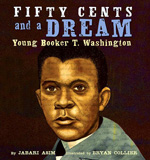 Written in a free verse style, this beautifully illustrated biography tells the life story of Booker T. Washington. Previous interpretations of Washington’s life have often run contrary to the concepts of the fight for freedom and true emancipation as seen in other versions and approaches to civil rights. In this version of his life story, author Jabari Asim presents the determination of a young man born into slavery, but given his freedom by the end of the Civil War years.
Written in a free verse style, this beautifully illustrated biography tells the life story of Booker T. Washington. Previous interpretations of Washington’s life have often run contrary to the concepts of the fight for freedom and true emancipation as seen in other versions and approaches to civil rights. In this version of his life story, author Jabari Asim presents the determination of a young man born into slavery, but given his freedom by the end of the Civil War years.
Through hard work and with just a few pennies in his pocket, he walked 500 miles to begin the academic life he so earnestly sought when he received admission into the Hampton Institute in Virginia. Working as a janitor while he was at Hampton, Booker earned his degree and went on to become a teacher, truly living the dream he had placed before himself as a young boy. Detailed author notes at the end of the book provide a timeline and further details of the life of this determined young learner.
Teachers will find an interesting interview with both author and illustrator at this popular children’s literature blog, Mr. Schu Reads.
—Karen Hildebrand, Ohio Library and Reading Consultant
Becker, Aaron. (2013). Journey. Somerville, MA: Candlewick Press.
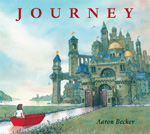 This magical story takes readers on a journey to far worlds through the imagination of one youngster. Left to her own devices as her family goes about their own pursuits and ignores her, a young girl picks up a red marker from her bedroom floor and proceeds to draw her own adventure, starting with a door in the wall. She leaves her room quickly as the door opens into a luminous, lush, green-filled natural world. By turns, she then draws a boat, a hot air balloon, and a flying carpet that enable her to travel to all sorts of places.
This magical story takes readers on a journey to far worlds through the imagination of one youngster. Left to her own devices as her family goes about their own pursuits and ignores her, a young girl picks up a red marker from her bedroom floor and proceeds to draw her own adventure, starting with a door in the wall. She leaves her room quickly as the door opens into a luminous, lush, green-filled natural world. By turns, she then draws a boat, a hot air balloon, and a flying carpet that enable her to travel to all sorts of places.
Her travels enable her to make new friends and encounter enemies determined to imprison a lovely lavender bird and the artist. After drawing her own escape, she finally meets the bird's creator with whom she apparently has quite a lot in common. The watercolor and pen and ink illustrations are filled with imaginative details and prompt readers to stretch their imaginations amid this marvelous wordless picture book.
—Barbara A. Ward, Washington State University Pullman
Belloni, Giulia. (2013). Anything is possible. Illus. by Marco Trevisan. Translated by William Anselmi. Toronto, ON: Owlkids.
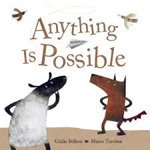 Teachers looking for ways to introduce the importance of math in early childhood will want to take a close look at this book. Sheep is so envious of the birds flying overhead that she gets the idea to build a flying machine. Knowing that her “friend” Wolf is really good at mathematics, she takes the idea to Wolf and asks him to help with the project. Wolf isn’t so sure about this crazy idea, but he gets busy with his ruler and protractor and starts to scribble mathematical equations and formulas all over the place.
Teachers looking for ways to introduce the importance of math in early childhood will want to take a close look at this book. Sheep is so envious of the birds flying overhead that she gets the idea to build a flying machine. Knowing that her “friend” Wolf is really good at mathematics, she takes the idea to Wolf and asks him to help with the project. Wolf isn’t so sure about this crazy idea, but he gets busy with his ruler and protractor and starts to scribble mathematical equations and formulas all over the place.
After several attempts, resignations, and failures, they are perplexed. Wings didn’t work and neither did helium balloons. With sparse text, the illustrations do a wonderful job at filling in the spaces for a young reader’s observation to take flight. Working together and showing determination and perseverance, the two unlikely friends discover a solution that works. A short YouTube video book trailer will help introduce the book to young readers.
—Karen Hildebrand, Ohio Library and Reading Consultant
Brown, Peter. (2013). Mr. Tiger goes wild. New York, NY: Little, Brown Books for Young Readers.
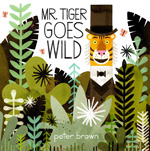 Mr. Tiger doesn’t do much roaring at the start of this picture book. In fact, as expected by cultural mores, any wild inclinations seem to have been buried deep within his striped body, and he has been thoroughly civilized, strapped into a coat, shirt, tie, and even a top hat. But he's bored with his lifestyle and longs to do something out of the norm. His first departure from what everyone else is doing is fairly simple, but as he continues to engage in increasingly daring acts, his friends and neighbors suggest that he leave so that his actions don’t offend their sensibilities. Although he does so, he misses the others' companionship. When he returns to civilization, it's on his own terms.
Mr. Tiger doesn’t do much roaring at the start of this picture book. In fact, as expected by cultural mores, any wild inclinations seem to have been buried deep within his striped body, and he has been thoroughly civilized, strapped into a coat, shirt, tie, and even a top hat. But he's bored with his lifestyle and longs to do something out of the norm. His first departure from what everyone else is doing is fairly simple, but as he continues to engage in increasingly daring acts, his friends and neighbors suggest that he leave so that his actions don’t offend their sensibilities. Although he does so, he misses the others' companionship. When he returns to civilization, it's on his own terms.
Mr. Tiger returns, but remains true to himself despite the efforts of others to enforce conformity. The accompanying illustrations, created with India ink, watercolor, gouache, and pencil and then digitally composed and colored, are filled with delights, including the opening pages filled with a muted palette that is relieved only by Mr. Tiger’s vibrant orange. As he frolics in the wilderness, the pages are covered in greens and flashes of Mr. Tiger's shimmering orange coat.
—Barbara A. Ward, Washington State University Pullman
Chin, Jason. (2013). Island: A story of the Galápagos. New York, NY: Roaring Brook Press/Macmillan Group.
 Starting with a volcanic eruption over six million years ago, this narrative nonfiction is beautifully designed beginning with end papers that are entitled “Species of the Galápagos” and contain thumbnail sketches for the very unusual plant and animal life that spawned on these unique volcanic islands. In rather simple language with beautiful paintings, the book is divided into five sections describing the evolution of the island: Birth, Childhood, Adulthood, Old Age and an Epilogue.
Starting with a volcanic eruption over six million years ago, this narrative nonfiction is beautifully designed beginning with end papers that are entitled “Species of the Galápagos” and contain thumbnail sketches for the very unusual plant and animal life that spawned on these unique volcanic islands. In rather simple language with beautiful paintings, the book is divided into five sections describing the evolution of the island: Birth, Childhood, Adulthood, Old Age and an Epilogue.
Interestingly, the epilogue is dated 1835, the year that Charles Darwin visited the islands and wrote about them for the world to know. The author has included detailed notes at the end of this biogeography to add further explanations for the appearance of the island and its strange inhabitants. This book was named one of the Outstanding Science Trade Books for 2013. Vist the author’s website with award news and more reviews or visit the publisher’s website for more enlargements of the interior art.
—Karen Hildebrand, Ohio Library and Reading Consultant
Cooper, Elisha. (2013). Train. New York, NY: Orchard Books/Scholastic, Inc.
 The beautiful language coupled with beautiful pictures make this book about trains an invitation to climb aboard. Cooper has presented a look at many different kinds of trains and travel. Starting with the red-striped commuter train that leaves the city passing little towns as they whiz past. Then a look at passenger trains and from Grand Central Station, a freight train leaves filled with all kinds of cargo traveling to distant places. An overnight train chugs its way across the country and over the Rocky Mountains. Finally, a bullet-shaped high-speed train takes its passengers on to the big cities of the west coast.
The beautiful language coupled with beautiful pictures make this book about trains an invitation to climb aboard. Cooper has presented a look at many different kinds of trains and travel. Starting with the red-striped commuter train that leaves the city passing little towns as they whiz past. Then a look at passenger trains and from Grand Central Station, a freight train leaves filled with all kinds of cargo traveling to distant places. An overnight train chugs its way across the country and over the Rocky Mountains. Finally, a bullet-shaped high-speed train takes its passengers on to the big cities of the west coast.
Cooper repeats the phrase, “passengers on, passengers off” throughout the various journeys in addition to bringing beautiful vistas and also interior views of these different types of trains. Each ride or train brings new experiences for young readers. Read more about the creation of this book in an interview on the blog, Seven Impossible Things Before Breakfast.
—Karen Hildebrand, Ohio Library and Reading Consultant
Daywalt, Drew. (2013). The day the crayons quit. Illus. by Oliver Jeffers. New York, NY: Philomel Books.
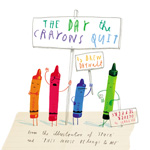 Duncan arrives at school one morning and reaches into his desk to pull out his box of crayons. Much to his surprise, he finds a stack of letters instead. The letters are from the crayons and they have decided to quit! The letters are from each color of crayon in his box specifically, with each stating its complaints. Red is tired, Peach is embarrassed, Beige is tired of being boring, Black is misunderstood, Yellow and Orange are spatting with each other, Pink feels undervalued, and so the moans and groans from each color are represented.
Duncan arrives at school one morning and reaches into his desk to pull out his box of crayons. Much to his surprise, he finds a stack of letters instead. The letters are from the crayons and they have decided to quit! The letters are from each color of crayon in his box specifically, with each stating its complaints. Red is tired, Peach is embarrassed, Beige is tired of being boring, Black is misunderstood, Yellow and Orange are spatting with each other, Pink feels undervalued, and so the moans and groans from each color are represented.
Jeffers’ wonderful pencil, paint, and crayon illustrations personify the emotions and disgruntlement of each character so that readers will understand their labor issues. Photographs of letters and coloring pages add another dimension to this cleverly designed book. Duncan is able to offer resolution to the crayon group so that everyone has a satisfying ending. Teachers will appreciate some of the lesson ideas for this book at the blog, The Classroom Bookshelf, or sharing the short slide show at the author’s website.
—Karen Hildebrand, Ohio Library and Reading Consultant
Floca, Brian. (2013). Locomotive. New York, NY: Atheneum Book for Young Readers.
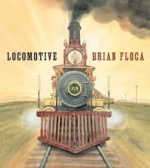 From end paper, title page, to page one and on to the last end paper, this beautifully designed book is a train-lover’s delight from start to finish. The front endpapers tell the story of the building of the Transcontinental Railroad so that the story within the pages shares the journey of an unnamed family traveling in 1869 from Omaha, Nebraska, to San Francisco, California.
From end paper, title page, to page one and on to the last end paper, this beautifully designed book is a train-lover’s delight from start to finish. The front endpapers tell the story of the building of the Transcontinental Railroad so that the story within the pages shares the journey of an unnamed family traveling in 1869 from Omaha, Nebraska, to San Francisco, California.
Told in poetic prose, readers will truly be immersed in the trip with sounds, colors, and images of train travel in those early days. The use of a wide variety, size and style of fonts adds to the kinetic feel of the journey. Floca takes reader/passengers from the engine to the caboose. The job of the conductor, the engineer, the coal man, and the newspaper boy are visible. Travel with the passengers as they get on and off at different towns, stop for a bite of food, explore parts of the train and watch the towns and parts of America fly by. Floca has identified the regions where the train is traveling.
Peek through the train windows as this nonfiction book takes young readers on an unforgettable train ride. Detailed notes on the history of the locomotive add further historical background on this visual narrative of early trains. Teachers will find three short videos talking with the author about the book. Read an interesting interview from Publisher’s Weekly with authors Brian Floca and Elisha Cooper as they discuss their new books, both entitled, Train. A detailed CCSS guide can be found at Brian Floca’s website.
—Karen Hildebrand, Ohio Library and Reading Consultant
Fogliano, Julie. (2013). If you want to see a whale. Illus. by Erin E. Stead. New York, NY: Roaring Brook Press.
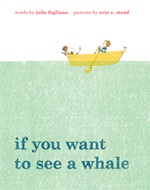 Anyone who has ever stared at clouds and imagined the possibilities in the sky or looked at the horizon and hoped to see something interesting approaching will be captivated by this picture book. Even while the story's two characters, a boy and his dog, wait as patiently as possible for a whale, there is much to distract them. While they’ve been advised to ignore everything else while they are waiting for that whale, they seem to be savoring the joys of the rest of the world during their vigil.
Anyone who has ever stared at clouds and imagined the possibilities in the sky or looked at the horizon and hoped to see something interesting approaching will be captivated by this picture book. Even while the story's two characters, a boy and his dog, wait as patiently as possible for a whale, there is much to distract them. While they’ve been advised to ignore everything else while they are waiting for that whale, they seem to be savoring the joys of the rest of the world during their vigil.
With its repetitive reminder “if you want to see a whale…” (unpaged), this title is a superb reminder that good things come to those who wait. Both the text and the illustrations, created with pencil and linoleum print techniques, are exemplary and sure to engage readers. The last two pages featuring a barnacle-encrusted whale swimming right under the boy's boat and then just the tip of the whale emerging from the briny waters are worth the wait. Readers may wonder if the whale was right there, beneath the boy’s notice, all along. Young readers will want to check out the animal-filled cloud shapes in the sky in one of the illustrations.
—Barbara A. Ward, Washington State University Pullman
Global baby girls. (2013). Text by The Global Fund for Children. Watertown, MA: Charlesbridge.
 The Global Fund for Children has produced several wonderful books for young children including Global Babies in 2006 and American Babies in 2010. This new addition to the series focuses on girls around the world. Full color photographs with baby girls in their native clothing present an emphasis on what girls can do. From countries as diverse as Russia, New Zealand, Liberia, India, Peru, France, China, Guatemala, Canada and the United States, the importance of young girls is visually brought to our youngest readers through this beautifully presented board book. Learn more about The Global Fund for Children and see some of the internal art for this book at their website.
The Global Fund for Children has produced several wonderful books for young children including Global Babies in 2006 and American Babies in 2010. This new addition to the series focuses on girls around the world. Full color photographs with baby girls in their native clothing present an emphasis on what girls can do. From countries as diverse as Russia, New Zealand, Liberia, India, Peru, France, China, Guatemala, Canada and the United States, the importance of young girls is visually brought to our youngest readers through this beautifully presented board book. Learn more about The Global Fund for Children and see some of the internal art for this book at their website.
—Karen Hildebrand, Ohio Library and Reading Consultant
Guiberson, Brenda Z. (2013). Frog song. Illus. by Gennady Spirin. New York, NY: Henry Holt.
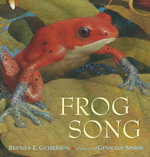 “CROAK! RIBBIT! Plonk! BRACK! Thrum-rum! Frogs have a song for trees, bogs, burrows and logs.” These are some of the opening lines to Frog Song, aptly named for the wonderful sounds and songs that emanate from this book. Teachers looking for a mentor text to teach onomatopoeia, look no further! Spirin’s beautiful double-page spread illustrations of frogs in their natural habitats around the globe provide the artistic backdrop for Guiberson’s poetic text about the music and sound of frogs.
“CROAK! RIBBIT! Plonk! BRACK! Thrum-rum! Frogs have a song for trees, bogs, burrows and logs.” These are some of the opening lines to Frog Song, aptly named for the wonderful sounds and songs that emanate from this book. Teachers looking for a mentor text to teach onomatopoeia, look no further! Spirin’s beautiful double-page spread illustrations of frogs in their natural habitats around the globe provide the artistic backdrop for Guiberson’s poetic text about the music and sound of frogs.
From the strawberry poison dart frogs in Costa Rica to the tarantula-eating narrow-mouthed toad of Oklahoma to the Surinam toad with no tongue from Ecuador each worldly frog is more interesting than the next. The author also sends out a strong environmental message at the end when she writes that frogs are in trouble. Forests and plants are drying up and disappearing so the habitats for the frogs are gone and their songs will be silenced if we do not take care of the planet. This book is a science treasure and the teaching guide that goes with it will be ever so helpful to teachers. The author and illustrator have worked together to create a beautiful resource guide with activities to accompany their book.
—Karen Hildebrand, Ohio Library and Reading Consultant
Hillenbrand, Will. (2013). Off we go: A Bear and Mole story. New York, NY: Holiday House.
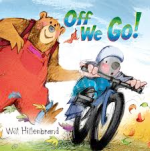 Come along with Hillenbrand’s third adventure with good friends, Bear and Mole. This time patient Bear is teaching Mole to ride a bike and they begin by taking off the training wheels. Fastening on his safety helmet, Mole is ready for takeoff. Bear pats his friend on the back for good luck and Mole begins his wobbly first attempt that ends in a crash landing with leaves flying and little critters fleeing. Mole is crying and discouraged, but Bear is there to help him try again. The second attempt is a success and Mole gains speed and confidence as he zooms away, just in time for the Storymobile. This promises to be a great read aloud and Hillenbrand has painted wonderful expressions on the faces of characters and used language that will keep young listeners engaged and laughing, though reminded of their first, or yet to be, attempts at riding a bike alone.
Come along with Hillenbrand’s third adventure with good friends, Bear and Mole. This time patient Bear is teaching Mole to ride a bike and they begin by taking off the training wheels. Fastening on his safety helmet, Mole is ready for takeoff. Bear pats his friend on the back for good luck and Mole begins his wobbly first attempt that ends in a crash landing with leaves flying and little critters fleeing. Mole is crying and discouraged, but Bear is there to help him try again. The second attempt is a success and Mole gains speed and confidence as he zooms away, just in time for the Storymobile. This promises to be a great read aloud and Hillenbrand has painted wonderful expressions on the faces of characters and used language that will keep young listeners engaged and laughing, though reminded of their first, or yet to be, attempts at riding a bike alone.
Will Hillenbrand has created a 6-minute video on the work behind this book that includes a short video of his son learning to ride a bike. Young readers will get a look at the behind-the-scenes work of an author/illustrator.
—Karen Hildebrand, Ohio Library and Reading Consultant
Hopkinson, Deborah. (2013). Knit your bit: A World War I story. Illus. by Steven Guarnaccia. New York, NY: Putnam Juvenile.
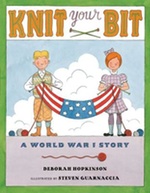 After their father leaves for service overseas during WWI, Ellie does her bit by joining her mother in knitting clothing for the service men. At first her brother Mikey considers knitting to be beneath him, but he changes his mind after his female classmates challenge him and his friends to enter a knitting bee in Central Park. Although the boys' work is nowhere near as professional as the girls' knitting, all of them feel satisfied to have done their bit for the soldiers by knitting.
After their father leaves for service overseas during WWI, Ellie does her bit by joining her mother in knitting clothing for the service men. At first her brother Mikey considers knitting to be beneath him, but he changes his mind after his female classmates challenge him and his friends to enter a knitting bee in Central Park. Although the boys' work is nowhere near as professional as the girls' knitting, all of them feel satisfied to have done their bit for the soldiers by knitting.
Mikey is especially moved by the attention of one soldier who tells him how much comfort the warm woolen objects will bring. The pen and ink and painted watercolor illustrations evoke a sense of pride and allow the woolen stitches in the knitted bits to be visible to readers. This title would be a perfect pairing with Lita Judge's One Thousand Tracings (Disney-Hyperion, 2007) for a text set illustrating how those on the home front brought comfort to others on the battle lines and abroad. Back matter includes information on the knitting bees and knitting clubs of the time as well as suggesting websites that provide ways young knitters can get involved even today. The endpapers containing photos of school children knitting add authenticity to the story told here.
—Barbara A. Ward, Washington State University Pullman
Idle, Molly Schaar. (2013). Flora and the flamingo. San Francisco, CA: Chronicle Books.
 Clad in her pink bathing suit, bathing cap, and flippers, Flora happens upon a beautiful and stately flamingo. In wordless text and lift-the-flap illustrations, Flora attempts to mimic the graceful movements of the flamingo, but as the lithe flamingo flexes in directions the stout little Flora can’t manage, Flora burst into tears. The flamingo patiently begins to teach Flora the dancelike movements of the graceful bird. A double-page spread fold-out bursts from the middle of the book as Flora and the flamingo enjoy the dance. Molly Idle worked in animation at DreamWorks and this talent is brought to life in this fanciful and beautiful wordless experience in print.
Clad in her pink bathing suit, bathing cap, and flippers, Flora happens upon a beautiful and stately flamingo. In wordless text and lift-the-flap illustrations, Flora attempts to mimic the graceful movements of the flamingo, but as the lithe flamingo flexes in directions the stout little Flora can’t manage, Flora burst into tears. The flamingo patiently begins to teach Flora the dancelike movements of the graceful bird. A double-page spread fold-out bursts from the middle of the book as Flora and the flamingo enjoy the dance. Molly Idle worked in animation at DreamWorks and this talent is brought to life in this fanciful and beautiful wordless experience in print.
—Karen Hildebrand, Ohio Library and Reading Consultant
Kearney, Meg. (2013). Trouper. Illus. by E. B. Lewis. New York, NY: Scholastic.
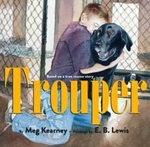 This picture book captures perfectly the universal desire for a home and someone to love. Even stray dogs long for a forever home and some comfort. Trouper is part of a large dog pack of various sizes and breeds. As they search for a meal, they cause disorder, and they endure cruelty from others. When a dogcatcher lures them into his truck, the pack ends up at a shelter. All of them are adopted except three-legged Trouper, whose lonely heart "was a cold, starless night" (unpaged) once his friends have left. Luckily for him, though, a tender-hearted boy adopts him and brings him home. The bond between the two is clear in the final illustrations.
This picture book captures perfectly the universal desire for a home and someone to love. Even stray dogs long for a forever home and some comfort. Trouper is part of a large dog pack of various sizes and breeds. As they search for a meal, they cause disorder, and they endure cruelty from others. When a dogcatcher lures them into his truck, the pack ends up at a shelter. All of them are adopted except three-legged Trouper, whose lonely heart "was a cold, starless night" (unpaged) once his friends have left. Luckily for him, though, a tender-hearted boy adopts him and brings him home. The bond between the two is clear in the final illustrations.
The text is filled with beautiful language that pays tribute to a brave dog and a boy who sees beneath an imperfect surface into that dog's spirit, while the watercolor illustrations capture perfectly the dog's anxiety, loneliness, and joy at having found someone "who liked the way I lean on those I love" (unpaged). Not only will this book inspire some to add a dog to their family, but it may convert a few feline lovers into canine aficionados. This is a wonderful book for sharing aloud and evoking a sense of compassion in others.
—Barbara A. Ward, Washington State University Pullman
Kelly, Susan and Deborah Lee Rose. (2013) Jimmy the joey: The true story of an amazing Koala rescue. Washington, D.C.: National Geographic Kids.
 Jimmy is a koala joey that was rescued when his mother was killed trying to cross a highway in Australia. Jimmy was found the next day and taken to the Koala Hospital. The volunteers there kept him warm and named him Jimmy. Only six months old, Jimmy is cared for like a human baby, though he is a marsupial. A volunteer named Barb, took Jimmy home with her to care for him. He slept in a laundry basket and cuddled with Barb like a living teddy bear. Eventually, Jimmy started to munch on eucalyptus leaves like all koalas do. By the time he was a year old, Jimmy was placed in the hospital’s tree yard so he could be with other koalas and where he learned to climb trees and develop a community with the other koalas. As Jimmy grew bigger it was time to release him back into his natural habitat in the forest.
Jimmy is a koala joey that was rescued when his mother was killed trying to cross a highway in Australia. Jimmy was found the next day and taken to the Koala Hospital. The volunteers there kept him warm and named him Jimmy. Only six months old, Jimmy is cared for like a human baby, though he is a marsupial. A volunteer named Barb, took Jimmy home with her to care for him. He slept in a laundry basket and cuddled with Barb like a living teddy bear. Eventually, Jimmy started to munch on eucalyptus leaves like all koalas do. By the time he was a year old, Jimmy was placed in the hospital’s tree yard so he could be with other koalas and where he learned to climb trees and develop a community with the other koalas. As Jimmy grew bigger it was time to release him back into his natural habitat in the forest.
The final pages of the book include a map, additional information, websites and places to visit to see koalas. Teachers will not want to miss the detailed teacher’s guide provided by the publisher with CCSS connections and also Jimmy’s own Facebook page! Visit the Koala Hospital page to see where Jimmy was given a second chance at life or the author’s page with early videos of Jimmy.
—Karen Hildebrand, Ohio Library and Reading Consultant
Lewis, J. Patrick, editor. (2012). National Geographic book of animal poetry; with favorites from Robert Frost, Jack Prelutsky, Emily Dickinson, and more: 200 poems with photographs that squeak, soar and roar! Washington, D.C., National Geographic.
 These animal poems were selected by J. Patrick Lewis to accompany the beautiful photography that only National Geographic can offer. The range of wonderful poets included makes this an exceptional anthology, but one especially helpful feature for teachers, in addition to the guide mentioned below, are the resources included in the back of the book. There are detailed indexes of poets, first lines, titles and subject, but also resources for many different kinds of poetic forms like portmanteaus, parodies, reversos, spoonerisms, lipograms, double dactyls, palindromes and more. “Writing Poems about Animals” is a guide for young writers to try their own hand at writing some animal poetry.
These animal poems were selected by J. Patrick Lewis to accompany the beautiful photography that only National Geographic can offer. The range of wonderful poets included makes this an exceptional anthology, but one especially helpful feature for teachers, in addition to the guide mentioned below, are the resources included in the back of the book. There are detailed indexes of poets, first lines, titles and subject, but also resources for many different kinds of poetic forms like portmanteaus, parodies, reversos, spoonerisms, lipograms, double dactyls, palindromes and more. “Writing Poems about Animals” is a guide for young writers to try their own hand at writing some animal poetry.
Teachers will enjoy this downloadable classroom guide to using this book. Listen to Poet Laureate J. Patrick Lewis read from this book at the Nat Geo Website.
—Karen Hildebrand, Ohio Library and Reading Consultant
Mader, Roger. (2013). Lost cat. New York, NY: Houghton Mifflin Harcourt Books for Young Readers.
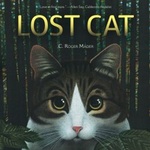 Feline lovers will be worried once they begin reading this picture book of a lost cat named Slipper. Part of that anxiety relates to imagining all the terrible things that might happen to her, and part of it relates to how the story effectively evokes empathy for Slipper as she characterizes each person according to his/her footwear. When Slipper’s human companion, Mrs. Fluffy Slippers, moves in with her daughter, somehow the cat is left behind in all the bustle of moving boxes and furniture. Once the humans realize that Slipper isn't with them, they return to Slipper’s house. But she has tried to follow them and is nowhere to be found. After a series of encounters with Ms. Muddy Boots, Mrs. Iron Shoes, Mr. Cowboy Boots, High Tops, Mr. Big Boots, and Miss Shiny Shoes, the cat somehow finds her way home.
Feline lovers will be worried once they begin reading this picture book of a lost cat named Slipper. Part of that anxiety relates to imagining all the terrible things that might happen to her, and part of it relates to how the story effectively evokes empathy for Slipper as she characterizes each person according to his/her footwear. When Slipper’s human companion, Mrs. Fluffy Slippers, moves in with her daughter, somehow the cat is left behind in all the bustle of moving boxes and furniture. Once the humans realize that Slipper isn't with them, they return to Slipper’s house. But she has tried to follow them and is nowhere to be found. After a series of encounters with Ms. Muddy Boots, Mrs. Iron Shoes, Mr. Cowboy Boots, High Tops, Mr. Big Boots, and Miss Shiny Shoes, the cat somehow finds her way home.
Rendered in pastels, the illustrations capture Slipper's physical features and personality in extraordinary fashion. Readers can see the affection she has for the slippers around which she sleeps and the determination with which she seeks out a new family. The artist is clearly familiar with the habits of felines, having captured perfectly Slipper's trust in her new family as she rolls onto her back and shows her belly and her delight in the sensuous pleasure experience while rubbing against a pair of fluffy slippers. Most of all, though, this picture book serves as a reminder to keep animal companions such as dogs and cats in carriers when moving from one place to another or when movers are present. Although Slipper's story ends happily, not every story like this does.
—Barbara A. Ward, Washington State University Pullman
Nelson, Kadir. (2013). Nelson Mandela. New York, NY: Katherine Tegen Books/imprint of HarperCollins.
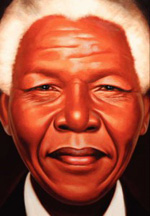 Kadir Nelson has once again created a children’s book masterpiece with his free verse writing and exquisite oil on birch plywood illustrations depicting the life of Nelson Mandela. Beginning with the full cover portrait of Mandela on the front, the title appears on the back of the book.
Kadir Nelson has once again created a children’s book masterpiece with his free verse writing and exquisite oil on birch plywood illustrations depicting the life of Nelson Mandela. Beginning with the full cover portrait of Mandela on the front, the title appears on the back of the book.
Kadir Nelson begins the life story of Mandela, or Rolihlahla, his Xhosa name, which means troublemaker. It was a schoolteacher who gave him the name Nelson. As a bright child, he listened to the stories of the village elders to learn of the history and exploitation of his country by Europeans. At the age of nine, he leaves his village to get an education and eventually becomes a lawyer. While he is on his path to education he also experiences the injustices of apartheid and gets a close look at what is happening in his cruelly segregated country. His decision to get politically involved to end apartheid eventually leads to his arrest and 30 years in prison. Upon his release from prison all those years later, he again returns to the political scene to become the President of South Africa and lead his country into a state of equality.
Kadir Nelson’s poetic prose does not go into all the difficulties Mandela encountered both politically and within his own personal life, but writes of the more philosophical journey of Mandela. Author notes at the end provide further back matter into Mandela’s life and triumphs. Visit Kadir Nelson’s webpage for a closer look at many of the illustrations in his new book or listen to this book summary on YouTube.
—Karen Hildebrand, Ohio Library and Reading Consultant
Sheth, Kashmira. (2013). Tiger in my soup. Illus. by Jeffery Ebbeler. Atlanta, GA: Peachtree Publishers.
 Avid readers will relate to this title in which a boy's older sister is too preoccupied with her own reading to read aloud her sibling’s book. So intent is she on her own pages that she doesn't even notice when a tiger appears in his bowl of soup. When she finally agrees to read his story aloud, the boy offers suggestions for how it should be read, and she sounds so much like a tiger that he can’t differentiate between his sister and the tiger. This amusing story is accompanied by acrylic illustrations that blend effectively the story’s realistic and fantastic elements. This is a delightful read aloud that pays tribute to the power of a good imagination and the joy of a good story.
Avid readers will relate to this title in which a boy's older sister is too preoccupied with her own reading to read aloud her sibling’s book. So intent is she on her own pages that she doesn't even notice when a tiger appears in his bowl of soup. When she finally agrees to read his story aloud, the boy offers suggestions for how it should be read, and she sounds so much like a tiger that he can’t differentiate between his sister and the tiger. This amusing story is accompanied by acrylic illustrations that blend effectively the story’s realistic and fantastic elements. This is a delightful read aloud that pays tribute to the power of a good imagination and the joy of a good story.
—Barbara A. Ward, Washington State University Pullman
Rosenthal, Eileen. (2013). Bobo the sailor man! Illus. by Marc Rosenthal. New York, NY: Atheneum Books for Young Readers.
 In a continuation of the adventures of three friends, a boy, a toy, and a cat, that were first introduced in I MUST Have Bobo (Atheneum, 2011) and I'll Save You, Bobo (Atheneum, 2012), Willy heads off for a busy day, making sure to bring along his beloved stuffed monkey, Bobo. When they arrive at the river and find a bucket, Willy decides that they can be sailors. But before he knows it, the bucket in which Bobo is going to sail has been swept into the current, sending Bobo far from shore. Although Willy can't use the slippery rocks that cross the river to rescue his friend, Earl rescues Bobo while Willy goes home to get a fishing pole.
In a continuation of the adventures of three friends, a boy, a toy, and a cat, that were first introduced in I MUST Have Bobo (Atheneum, 2011) and I'll Save You, Bobo (Atheneum, 2012), Willy heads off for a busy day, making sure to bring along his beloved stuffed monkey, Bobo. When they arrive at the river and find a bucket, Willy decides that they can be sailors. But before he knows it, the bucket in which Bobo is going to sail has been swept into the current, sending Bobo far from shore. Although Willy can't use the slippery rocks that cross the river to rescue his friend, Earl rescues Bobo while Willy goes home to get a fishing pole.
The pencil and digitally colored illustrations are appealing, allowing the growing annoyance of the long-suffering and under-appreciated Earl to be more visible with each passing page. When Willy fashions official explorer hats for Bobo and him, it's pretty clear that Earl is fed up with his treatment. After Willy falls asleep, he gets his revenge.
—Barbara A. Ward, Washington State University Pullman
Roth, Susan L. (2013). Parrots over Puerto Rico. Illus. by Cindy Trumbore. New York, NY: Lee & Low.
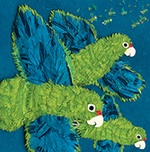 By 1975, only 13 Puerto Rican parrots remained in the wild, a far cry from the multitude of birds that once filled the skies of the island. Through the efforts of determined individuals who didn't want them to disappear, artificial nesting boxes were placed in the forests, and some of the birds were captured and moved to an aviary. This inspiring story tells the intertwined story of Puerto Rico and its beautiful birds and how they came back from the brink of extinction, having battled hurricanes, invasive species, and human encroachment. The text is lively, engaging, and filled with appreciation for the birds and their struggle against long odds while the paper and fabric collage illustrations are almost as mesmerizing as the actual parrots must be. What a terrific story of survival to add to the classroom shelves!
By 1975, only 13 Puerto Rican parrots remained in the wild, a far cry from the multitude of birds that once filled the skies of the island. Through the efforts of determined individuals who didn't want them to disappear, artificial nesting boxes were placed in the forests, and some of the birds were captured and moved to an aviary. This inspiring story tells the intertwined story of Puerto Rico and its beautiful birds and how they came back from the brink of extinction, having battled hurricanes, invasive species, and human encroachment. The text is lively, engaging, and filled with appreciation for the birds and their struggle against long odds while the paper and fabric collage illustrations are almost as mesmerizing as the actual parrots must be. What a terrific story of survival to add to the classroom shelves!
—Barbara A. Ward, Washington State University Pullman
Singer, Marilyn. (2013). Follow, follow: A book of reverso poems. Illus. by Josee Masse. New York, NY: Dial Books for Young Readers.
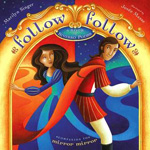 Following the popular Mirror, Mirror (Dutton, 2010), Marilyn Singer has written a second book based on fairy tales using the reverso format in which the poems are presented forward and backward. For example, in this new edition from the tale of “The Emperor’s New Clothes,” comes Singer’s “The Birthday Suit” (p. 5): “Behold his glorious majesty:/me,/Who dares say he drained the treasury/on/nothing?/Ha!/This emperor has/sublime taste in finery!/ Only a fool could fail to see./ Now read the verso poem of the same tale: “Only a fool could fail to see./Sublime taste in finery?/This emperor has-/ha!/nothing/on!/Who dares say he drained the treasury?/Me./Behold his glorious majesty!/ From “The Little Mermaid’s Choice” to “Your Wish is my Command” to “The Silly Goose,” Singer has cleverly created poems that beg to be read aloud with two voices, punctuation emphasis and perhaps a theatric or two for a truly enjoyable poetry experience. Visit Marilyn Singer’s website to learn more about her work.
Following the popular Mirror, Mirror (Dutton, 2010), Marilyn Singer has written a second book based on fairy tales using the reverso format in which the poems are presented forward and backward. For example, in this new edition from the tale of “The Emperor’s New Clothes,” comes Singer’s “The Birthday Suit” (p. 5): “Behold his glorious majesty:/me,/Who dares say he drained the treasury/on/nothing?/Ha!/This emperor has/sublime taste in finery!/ Only a fool could fail to see./ Now read the verso poem of the same tale: “Only a fool could fail to see./Sublime taste in finery?/This emperor has-/ha!/nothing/on!/Who dares say he drained the treasury?/Me./Behold his glorious majesty!/ From “The Little Mermaid’s Choice” to “Your Wish is my Command” to “The Silly Goose,” Singer has cleverly created poems that beg to be read aloud with two voices, punctuation emphasis and perhaps a theatric or two for a truly enjoyable poetry experience. Visit Marilyn Singer’s website to learn more about her work.
—Karen Hildebrand, Ohio Library and Reading Consultant
Stinson, Kathy. (2013). The man with the violin. Illus. by Dusan Petricic. Postscript by Joshua Bell. Toronto: Annick Press.
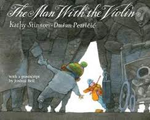 Like everyone else in the subway station, Dylan and his mother were bustling along. When Dylan heard the beautiful strains of music coming from a street musician playing a violin, he wanted to stop and listen. His mother did not want to listen though Dylan begged, but his mother grabbed his hand and continued rushing him along with the crowds. But the music stayed dancing in Dylan’s head. When he got home he turned on the radio and listened to the droning of the announcer until the same beautiful violin music that he had heard in the subway station flowed out of the radio.
Like everyone else in the subway station, Dylan and his mother were bustling along. When Dylan heard the beautiful strains of music coming from a street musician playing a violin, he wanted to stop and listen. His mother did not want to listen though Dylan begged, but his mother grabbed his hand and continued rushing him along with the crowds. But the music stayed dancing in Dylan’s head. When he got home he turned on the radio and listened to the droning of the announcer until the same beautiful violin music that he had heard in the subway station flowed out of the radio.
The radio announcer went on to tell his broadcast audience that the famous violinist, Joshua Bell, had conducted an experiment playing his famous and valuable Stradivarius violin in a free concert in the subway station that day and yet only a very few stopped to listen for even a minute. The musician noticed that several children tried to get their parents to stop long enough to hear the captivating violin, but parents were too busy.
Based on a true story that Joshua Bell relates at the end of the book, teachers can download two of the songs Joshua played that day in the Washington, D.C. L’Enfant Plaza Metro Station when over a thousand people did not take time to listen to one of the world’s greatest violinists. Annick Press has created an excellent 5-minute book trailer with the author giving the back matter of this talented man.
—Karen Hildebrand, Ohio Library and Reading Consultant
Tuck, Pamela M. (2013). As fast as words could fly. Illus. by Eric Velasquez. New York, NY: Lee and Low Books.
 Based on the life of the author’s father, Pamela Tuck relives a moment in the civil rights movement of the 1960’s in Greenville, North Carolina. Young Mason Steele is a good writer and when his activist father needs help writing letters to civil rights leaders or people who have discriminated against Negroes, he dictates letters that Mason puts into words and letters. At one point the local civil rights organization finds a way to get Mason a real typewriter to help with his father’s letters.
Based on the life of the author’s father, Pamela Tuck relives a moment in the civil rights movement of the 1960’s in Greenville, North Carolina. Young Mason Steele is a good writer and when his activist father needs help writing letters to civil rights leaders or people who have discriminated against Negroes, he dictates letters that Mason puts into words and letters. At one point the local civil rights organization finds a way to get Mason a real typewriter to help with his father’s letters.
One day, his father calls Mason and his two brothers into the kitchen and tells them they will be going to the all-white high school that is much closer than their segregated school. The boys are very nervous about this new turn in their lives, especially when the school bus drives right on by them the first two days of school. When they finally get picked up they are made to sit in the back of the bus. Though Mason excels at school especially in typing class, it is a very strained and difficult school atmosphere for Mason and the other black students. Mason is able to get a job in the library typing cards for the school librarian that adds more experience to his typing skills. When his typing teacher, Mrs. Roberts, announces a tournament Mason is selected as the candidate to represent the school. At the contest, he has to choose between an electric and a manual typewriter for the tournament. He chooses the manual typewriter and when the contest begins, his fingers fly across the keyboard to win the tournament. No one cheers or applauds. No one congratulates Mason. He received nothing. Later, when his principal, Mr. Bullock, asked him why he chose the manual typewriter, Mason replied, “Cause it reminds me of where I come from, sir.” (p. 31)
The book concludes with detailed notes from the author about her father’s experience and describes the civil rights movement of the 1960’s. Read more about the background of this story at the publisher’s website.
—Karen Hildebrand, Ohio Library and Reading Consultant
Wiesner, David. (2013). Mr. Wuffles! New York, NY: Houghton Mifflin/Clarion Books.
 Just like many felines, Mr. Wuffles is particularly choosy when it comes to toys. Despite his human companion's efforts to interest him in a series of toy mice, feathery creations, and a fish on a string, the disdainful cat is completely disinterested. He becomes fascinated by a shiny metal spacecraft filled with aliens. Filled with close-up depictions of Mr. Wuffles keeping a watchful eye on the craft, clutching it in his paws, rolling it along the floor, and blissfully rubbing his chin against it, this picture book with its distinctive watercolor and India ink illustrations is vintage David Wiesner.
Just like many felines, Mr. Wuffles is particularly choosy when it comes to toys. Despite his human companion's efforts to interest him in a series of toy mice, feathery creations, and a fish on a string, the disdainful cat is completely disinterested. He becomes fascinated by a shiny metal spacecraft filled with aliens. Filled with close-up depictions of Mr. Wuffles keeping a watchful eye on the craft, clutching it in his paws, rolling it along the floor, and blissfully rubbing his chin against it, this picture book with its distinctive watercolor and India ink illustrations is vintage David Wiesner.
Needless to say, all Mr. Wuffles’ rough treatment damages the craft, and the aliens set off on a dangerous mission right under the cat’s nose and claws in search of materials with which to make repairs. They form an alliance with several insects and eventually make their escape. Fans of this talented visual storyteller will recognize many of his favorite themes and images while being thoroughly entertained by his efforts. This is another winner in a long line of exceptional picture books by a master.
—Barbara A. Ward, Washington State University Pullman
These reviews are submitted by members of the International Reading Association's Children's Literature and Reading Special Interest Group (CL/R SIG) and are published weekly on Reading Today Online.